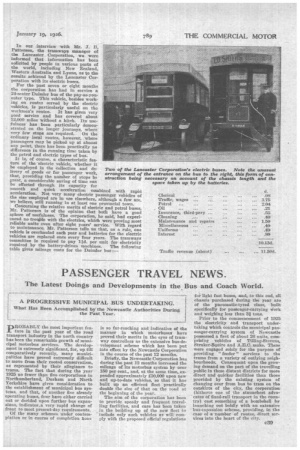PASSENGER TRAVEL NEWS.
Page 23

Page 24

If you've noticed an error in this article please click here to report it so we can fix it.
The Latest Doings and Developments in the Bus and Coach World.
A PROGRESSIVE MUNICIPAL BUS UNDERTAKING.
What Has Been Accomplished by the Newcastle Authorities During the Past Year,
pROBABLY the most important feature in the past year of the road transport industry in the north country has been the remarkable growth of municipal motorbus services. The development is extremely significant, for, up till comparatively recently, many municipalities have proved extremely difficult to move from their rooted conservatism, as represented by their allegiance to trams. The fact that during the year 1925 no fewer than five corporations in Northumberland, Durham and North Yorkshire have given consideration to the establishment of municipal bus systems, and that, of another five already operating buses, four have either carried out or decided upon further bus expansions, indicates.a very rapid change of front to meet present-day requirements.
Of the many schemes under contemplation or in course of completion hone
is so far-reaching and indicative of the manner in which motorbuses have proved their merits in the eyes of tramway controllers as the extensive bus-development scheme which has been put into effect by the Newcastle Corporation in the course of the past 12 months.
Briefly, the Newcastle Corporation has during the past 12 months increased the mileage of its motorbus system by over 150 per cent., and, nt the same time, expended approximately £30,000 upon new and up-to-date vehicles, so that it has built up an efficient fleet practically double the size of that on the road at the beginning of the year.
The aim of the corporation has been to provide speedy and frequent travelling facilities, and care has been taken in the building up of the new fleet to include only such vehicles as will comply with the proposed official regulations
for light fast buses, and, to this end, all chassis pm-chased during the year are of the pneumatic-tyred class, built specifically for passenger-carrying work and weighing less than 31 tons.
Prior to the commencement of 1925 the electricity and transport undertaking which controls the municipal passenger-carrying system of Newcastle possessed a fleet of about 26 units, comprising vehicles of Tilling-Stevens. Straker-Squire and A.E.C. make. These were engaged solely for the purpose of providing " feeder " services to the trams from a variety of outlying neighbourhood. Consequent upon the growing demand on the part of the travelling public in these distant districts for more direct and quicker facilities than those provided by the existing system of changing over from bus to tram on the outskirts of the city, the corporation (hitherto one of the staunchest advocates of fixed-rail transport in the country) cast something of a bombshell by launching out boldly with an extensive bus-expansion scheme, providing, in the case of a number of routes, direct services into the heart of the city.
In order to carry out this progressive development, orders were placed with the makers of the Guy, A.E.C. and Dennis chassis for 18 new vehicles. These deliveries were made by the middle of the year, and the corporation had then in commission a smart fleet of 28-seater single-decker "Blue" buses, which had been acquired at a total cost of about £20,000.
It was then possible to proceed with the elaborate plans made, and, for the first time in the history of the authority, direct municipal bus services from outlying districts into the city were instituted. All the buses were shod with pneumatic tyres and fitted with bodies constructed by Messrs. Strachan and Brown.
Further extensive developments have taken place since that time, and during the year the electricity and transport undertaking received sanction from the city council to spend up to 160,000 upon the purchase of vehicles as required. To date approximately one-half
this sum has date, expended, and the fleet now numbers 44 buses, all of the single-deck Baleen type. These comprise twenty-six 28-seater A.E.C.s, five 28seater Dennis's, six 28-seater Guys, five 28-seater Daimlers, and two 36-seater A.E.C.s. In the majority of cases Dunlop pneumatic tyres are fitted and are stated to be giving very satisfactory results,
Whereas, in January, 1925, the corporation only operated a route mileage of about 37, the motorbus system at the beginning of the present year covered 87 miles, the services radiating in all directions from the city, and providing regular and frequent transport facilities over an extensive agricultural and industrial area. The routes which are
operated at the present time are the following :—Newcastle, Scotswood, Blaydon, Ryton, Prudhoe and Stocksfield ; Newcastle, Seaweed, Blaydon, Crawcrook ; Newcastle, Scotewood, Blaydon, Clara Vale ; Newcastle (Haymarket), Ponteland, Belsay ; Newcastle, Hexham ; Newcastle Coxlodge ; Newcastle, Seaton Sluice • !West Moor, Cramlington and the Allotments; Slatyford and Weesterhope.
Vehicles working on routes running to and from the centre of the city run from three main termini, and the effect of the introduction of buses upon this class of work has been to transfer a tremendous amount of traffic in outlying neighbourhoods from the tramways, and thereby free that mode of locomotion entirely for inter-city traffic.






























